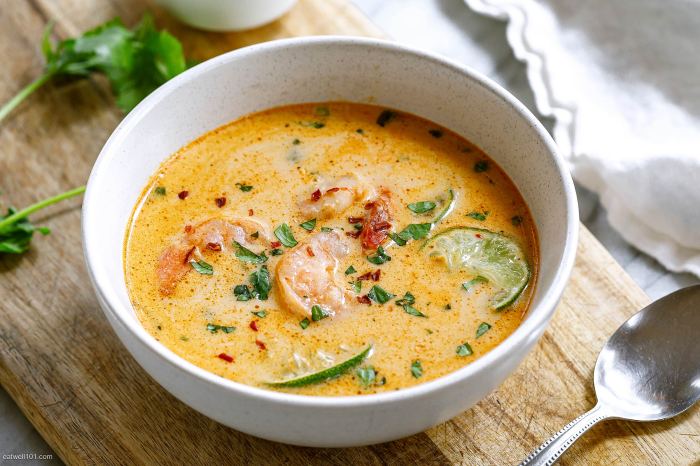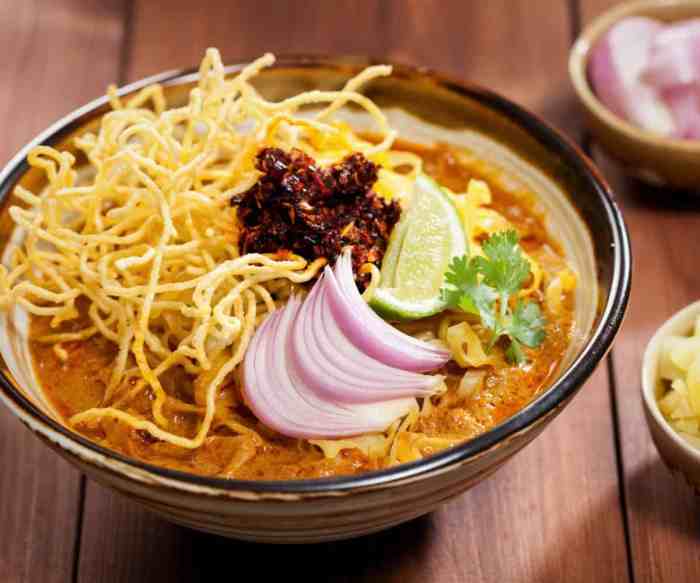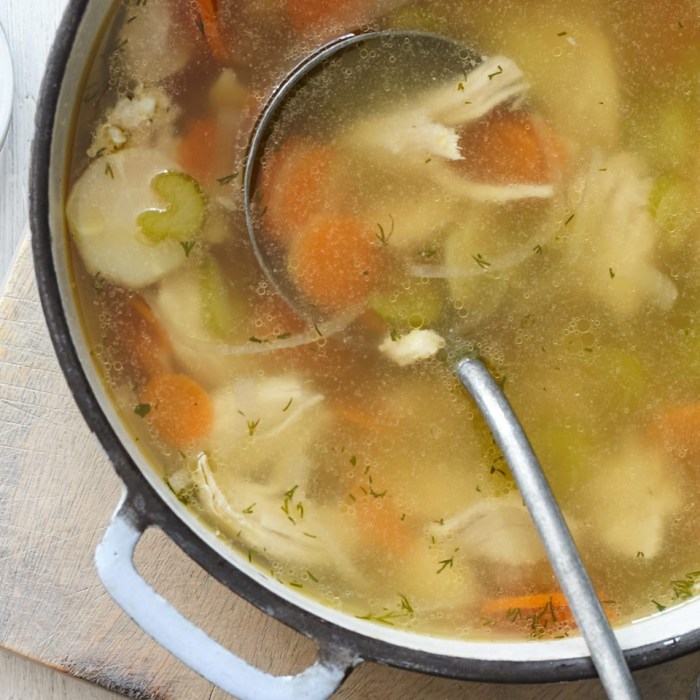A Diverse World of Thai Soups
Thai food soup recipes – Thai cuisine boasts a rich tapestry of flavorful soups, each reflecting the country’s diverse culinary heritage and regional influences. These soups aren’t merely appetizers; they are often the heart of a meal, showcasing a complex interplay of sweet, sour, salty, spicy, and sometimes bitter notes. The variety is astonishing, ranging from light and refreshing broths to rich and creamy concoctions, all united by their vibrant aromatics and balanced flavors.
Thai Soup Categories and Key Ingredients
Thai soups fall into several broad categories, each with its own distinct character. Clear broths, like tom yum, emphasize the bright flavors of herbs and spices, while creamy soups, such as tom kha, offer a rich and comforting experience. Spicy soups are a hallmark of Thai cuisine, employing chilies to deliver a range of heat levels, from gentle warmth to fiery intensity.
The key ingredients commonly found across these categories include a variety of herbs (lemongrass, galangal, kaffir lime leaves), spices (chilies, peppercorns), vegetables (onions, mushrooms, tomatoes), and proteins (shrimp, chicken, tofu).
Tom Yum Soup
Tom yum, a quintessential Thai soup, is renowned for its intensely flavorful broth and balance of sour, spicy, and savory notes. Its popularity stems from its adaptability; variations abound, catering to diverse tastes and dietary needs.
Tom Yum Soup: Essential Ingredients and Vegetarian Adaptation

Source: eatwell101.com
A classic Tom Yum Goong (shrimp) relies on a foundation of lemongrass, galangal, kaffir lime leaves, chilies, and shrimp. The broth is typically seasoned with fish sauce, lime juice, and sugar, creating a complex harmony of flavors. For a vegetarian version, simply omit the shrimp and substitute with firm tofu, mushrooms, or vegetables like bamboo shoots and baby corn.
The herbal and spicy elements remain the stars, ensuring a satisfyingly flavorful vegetarian experience.
Tom Yum Goong vs. Tom Yum Gai
While both Tom Yum Goong (shrimp) and Tom Yum Gai (chicken) share the same fundamental flavor profile, the protein choice subtly alters the overall taste. Tom Yum Goong offers a delicate sweetness from the shrimp, complementing the sour and spicy elements. Tom Yum Gai, on the other hand, provides a richer, more savory depth from the chicken, resulting in a heartier soup.
Tom Yum Soup Recipe
| Ingredients | Instructions | Tips | Notes |
|---|---|---|---|
| Lemongrass, Galangal, Kaffir Lime Leaves | Bruise gently and simmer in water. | Use fresh herbs for the best flavor. | Adjust quantities based on desired intensity. |
| Chilies | Add to the broth for desired spiciness. | Start with fewer chilies and add more gradually. | Bird’s eye chilies provide intense heat. |
| Shrimp/Chicken | Add protein towards the end of cooking. | Don’t overcook the protein. | Use high-quality ingredients for optimal taste. |
| Fish Sauce, Lime Juice, Sugar | Season to taste. | Taste and adjust seasoning frequently. | Balance sour, salty, and sweet flavors carefully. |
| Mushrooms, Tomatoes | Add vegetables as desired. | Choose firm mushrooms that hold their shape. | Consider adding other vegetables like bamboo shoots. |
Tom Kha Soup
Tom Kha, often called Thai coconut soup, differs significantly from Tom Yum in its creamy texture and the prominent use of coconut milk. While both soups can be spicy, Tom Kha generally features a milder heat level, allowing the rich coconut flavor to shine.
Tom Kha Gai Recipe and Spiciness Adjustment, Thai food soup recipes
Tom Kha Gai (chicken coconut soup) starts with a base of coconut milk, lemongrass, galangal, and kaffir lime leaves. Chicken is added for a savory element, and the soup is seasoned with fish sauce, lime juice, and sugar. The level of spiciness can be easily adjusted by adding more or fewer chilies; start with a small amount and add gradually to your preference.
For a truly mild soup, omit the chilies altogether.
Tom Kha Soup Ingredient Substitutions
- Coconut milk: Can be substituted with full-fat coconut cream for a richer texture.
- Chicken: Easily replaced with tofu, mushrooms, or shrimp.
- Fish sauce: Soy sauce or tamari can be used as a substitute (adjust the amount to taste).
- Lemongrass, Galangal, Kaffir Lime Leaves: While fresh is best, you can use dried versions, but the flavor might be less intense.
Other Notable Thai Soups
Beyond the well-known Tom Yum and Tom Kha, Thai cuisine offers a treasure trove of lesser-known but equally delicious soups. Each showcases unique regional flavors and ingredients.
Three Lesser-Known Thai Soups
1. Gaeng Jued (Southern Thai Curry Soup): This rich and aromatic soup, originating from Southern Thailand, features a vibrant red curry paste as its base, lending a deep, savory flavor. The addition of coconut milk provides a creamy texture, while vegetables like eggplant, green beans, and okra add depth and texture. The aroma is a captivating blend of spices and coconut, with a taste that is both spicy and satisfying.
The texture is rich and creamy, with tender vegetables.
2. Tom Klong (Clear River Soup): A light and refreshing soup, Tom Klong is typically made with a clear broth, featuring a delicate balance of herbs and vegetables. The broth is light and flavorful, with a hint of sweetness. The texture is light and refreshing, perfect for a hot day. The aroma is light and fragrant, with subtle herbal notes.
Often includes fish, shrimp, or tofu.
3. Yam Nua (Spicy Beef Salad Soup): This soup, often served slightly warm or at room temperature, is a unique combination of salad and soup. It features thinly sliced beef, a vibrant mix of herbs and vegetables, and a spicy, tangy dressing. The aroma is fresh and herbaceous, with a hint of spice. The texture is lively and refreshing, with a mix of crunchy vegetables and tender beef.
The taste is a delightful blend of sweet, sour, spicy, and savory notes.
Thai food soup recipes offer a vibrant range of flavors, from the creamy richness of tom kha to the spicy heat of tom yum. For a completely different culinary experience, consider a hearty potato soup, perhaps one like the comforting recipe found here: potato soup recipe with hash browns. Returning to Thai cuisine, the variety of ingredients and techniques used in their soups make them endlessly fascinating to explore.
Serving and Garnishing Thai Soups
Proper serving and garnishing elevate the Thai soup experience, enhancing both the visual appeal and the overall enjoyment.
Garnishes and Serving Temperature
Common garnishes include fresh cilantro, lime wedges, chilies (for added heat), and sometimes a sprinkle of chopped peanuts or crispy fried shallots. The ideal serving temperature varies depending on the type of soup. Clear broths like Tom Yum are best served hot, while creamy soups like Tom Kha can be enjoyed slightly warmer or even at room temperature.
Accompanying Dishes

Source: hot-thai-kitchen.com
Thai soups are often served with steamed rice, which acts as a perfect counterpoint to the flavorful broth. Other accompaniments might include fresh vegetables, such as cucumber slices or bean sprouts, or a side of grilled meats or tofu.
A Visually Appealing Tom Yum Soup
Imagine a steaming bowl of Tom Yum Goong, the vibrant orange of the shrimp contrasting beautifully with the green of the cilantro and the bright red of the chilies. A few thin slices of lime are nestled amongst the ingredients, their pale yellow adding a refreshing touch. The steam rising from the soup creates a sense of warmth and invites the diner to partake in the flavorful experience.
Adapting Thai Soup Recipes
Thai soup recipes are remarkably versatile and can be adapted to suit various dietary needs and preferences.
Dietary Adaptations and Spice Level Adjustments
Vegan adaptations are easily achieved by substituting fish sauce with soy sauce or tamari, and using vegetable broth instead of chicken or fish broth. Gluten-free versions require careful attention to the ingredients; ensure that all sauces and condiments are gluten-free. Adjusting the spice level is simple: add more or fewer chilies depending on your preference. For those sensitive to spice, consider using milder chilies or adding a touch of sugar to balance the heat.
Making Large Batches and Storage
To make large batches for parties or events, simply multiply the recipe ingredients proportionally. Leftover Thai soup can be stored in airtight containers in the refrigerator for up to 3 days. Reheat gently on the stovetop or in the microwave, avoiding boiling, which can diminish the flavor and texture.
FAQ Insights: Thai Food Soup Recipes
Can I use frozen shrimp in Tom Yum soup?
Yes, but ensure they are fully thawed and patted dry before adding them to the soup to prevent it from becoming watery.
How long can I store leftover Thai soup?
Leftover Thai soup can be stored in an airtight container in the refrigerator for up to 3 days.
What are some good substitutes for galangal?
Ginger can be used as a partial substitute for galangal, although it won’t provide the exact same flavor profile.
Are Thai soups typically served hot or cold?
Most Thai soups are traditionally served hot, although some variations can be enjoyed at room temperature.


